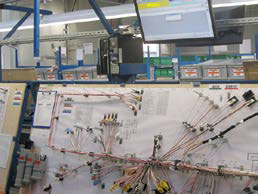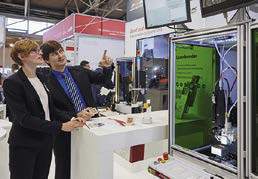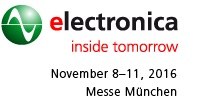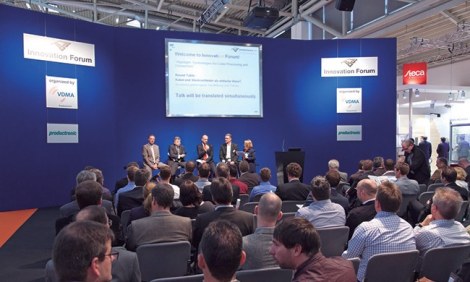Although everyone is talking about “wireless” these days, major technological challenges like the energy transition, high-speed internet, Industry 4.0, and electric mobility will not happen without wires. Consequently, the Cables, Coils & Hybrids group was already one of the highlights of the trade fair for the latest productronica. This year, Hall A5 will contain the framework, in which exhibitors and visitors will be able to exchange information on the latest developments and production technologies in this area. Productronica will take place on the Messe München site from November 14 to 17, 2017. According to the current business climate survey conducted by the VDMA specialist department Productronic, the German manufacturers of components, machinery and equipment for electronics production they expect sales growth of 10,5 percent for this year and an increase of 6,8 percent for next year. In addition to the continued weak euro, this is due to the increasing demand from the automotive industry for electronics and the increasing digitization and networking in the production and consumer sectors. The current outlook in the global electronics market also looks promising. The German Association of Manufacturers of Electrical and Electronic Equipment (ZVEI) forecasts a 4% increase for the current year and 2018. As a result, the growth rate of one of the largest markets for industrial goods in the world remains stable. In other words, good news for wires and coils. Because they transmit or transform electrical energy and electronic data, they are in demand by virtually all sectors of industry.
Wires: The Direct Line
For example, hidden cables form the circulatory system of each network. Wireless competition is often limited in terms of stability, data protection, and speed in this regard. Therefore, conventional lines for communication and control cannot yet be replaced by "wireless" in many areas. The requirements for cables are as varied as the applications. They must not only function properly, but also carry high currents, tolerate heat, be immune to electromagnetic interference, and be biocompatible for medical purposes. In addition, they have to withstand extreme mechanical loads in industrial robotics. Electrical systems in modern vehicles must also be cheaper and lighter, along with optimal reliability and improved functionality. This means higher quality, automation and productivity requirements for cable production. In addition, faulty connections or cable breaks can have fatal consequences for assistance systems and autonomous vehicles. The still high manual quota makes highly efficient error prevention and software-controlled quality control imperative. “Universal” Manufacturing Execution Systems (MES) do not support these requirements. This is why companies like Komax, an exhibitor at productronica for 30 years, and DiLT have developed an MES that provides continuous transparency in all production areas and is exactly tailored to the cable processing industry.
Quality thanks to automation
Schleuniger, winner of last year's productronica innovation award, also delivers quality with SmartDetect. The sensor-controlled system monitors the entire insulation process in real time and detects unwanted stripping blade contact with the conductor to automatically prevent stripping failures. The demand is increasing in general for automated and flexible machining systems. For example, Schleuniger's ShieldCut 8100 cuts braided shielding from cable shields semi-automatically and thus makes processing precision independent of the respective operator. In the construction of the control cabinets there is also a great potential for unsuspected rationalization. Komax realizes this potential with the Zeta 630 cable machine. It automatically assembles complete cable assemblies and reduces wiring time by 50 percent from a batch of one.
Plug connectors: disconnect and connect
Cordless without the associated connection technique. This is closely related to cable technology and therefore depends on actual use. For example, the crimping method for plug-in connectors must be adapted with the replacement of copper by aluminum in automotive construction. For use in medical devices, liquid intrusion of any kind should normally be avoided. Other requirements are flexible PCB connectors for the automotive and industrial sectors, such as the SUMIDA flexible connections from Radeberg supplies or the plug-in connectors from TE connectivity, which turn a home into a “connected home”.
Coil production: magnetic field design at the highest level
Regardless of whether it's an electric motor, transformer, or magnetic field sensor, inductive component applications couldn't be more different. Each is subject to different demands. However, the following applies to all electric machines: smaller, lighter and above all more efficient. After all, drive systems consume a considerable 70 percent of industrial electricity, which is increasingly resulting in international standards and national laws for the purpose of energy saving. This means that the industry requires innovations both in process technologies and insulating materials. For example, this can be achieved by using friction-optimized winding wires, which improve both the efficiency of electric motors and their output. Specialists in the field are Meteor and Marsilli, among others. However, coils can also be found in actuators for dispensing, moving or locking in the medical field. A custom pinch valve can be “built” with Schlaeger M-Tech's high-clamping-force modular magnetic assemblies, for example.
Hybrid components: two in one
Smaller, lighter, more compact and less expensive: Customized components in the combination of metal and plastic meet these requirements. They combine the advantages of different materials and can therefore fulfill several functions at the same time. Customers are mainly from the automotive industry, the communications industry and electronics. A number of productronica exhibitors will be showcasing innovative mixed (hybrid) manufacturing methods for one-step injection molding of plastic components with metal layers or metal-bonded plastic components.
www.productronica.com






